Previous Then & Now | BIG History is Happening
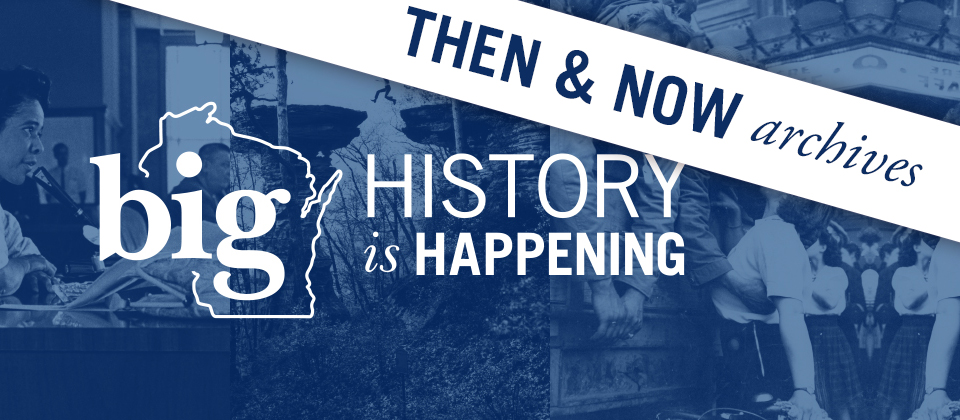
BIG History Is Happening
A BIG moment in history is happening right now. COVID-19 is having a major impact on all of our lives. As we practice social distancing, and spend more time at home, it is easy to feel isolated from the things you love. We know how much you love history, and until we can welcome you back to the Society, the Library & Archives, and our sites and museums, we are going to bring more history straight to you! Here you can peruse past posts we've featured as part of BIG History is Happening! Click below to return to BIG History is Happening and explore more of our Wisconsin History.
Learn MoreJoin the COVID-19 Journal Project
Did you journal during Covid-19? Share it with us and become part of history!
Learn HowTeachers Adapting in a Crisis
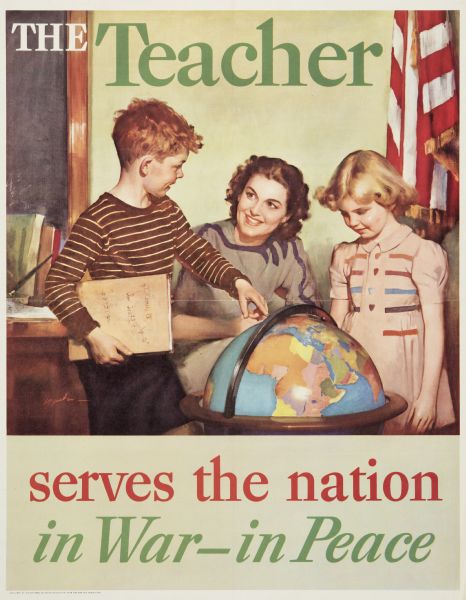
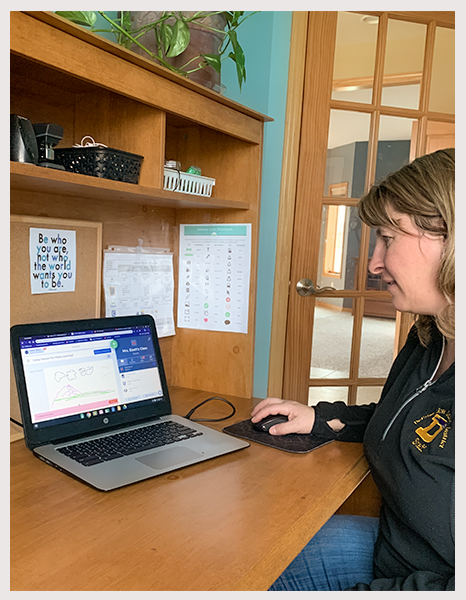
Teachers & Adapting in a Crisis
Teachers are some of the most integral members of our communities. They inspire and educate generations of children, sharing knowledge from the past to help shape a brighter future. It is a huge responsibility, one made even more difficult in times of hardship when the standard resources, supplies, and even the ability for teachers to interact face-to-face with their students are not available. In spite of these challenges, time and time again, teachers have risen to the occasion. They adapt their methods, not only allowing their important work to continue, but also adjusting their work in ways that fundamentally reshapes the educational system for the better.
The above poster, published by the National Education Association during World War II, perfectly summarizes the sentiment that an educator’s work doesn’t stop when the world around them changes. Also above is a photo of Windsor Elementary kindergarten teacher Carey Eiselt working on a virtual learning assignment for her students during the COVID-19 Pandemic, an example of how this sentiment continues as we write this new chapter of history.
COVID-19 has forced schools to close, sending students home or online to learn. Field trips and outreach programs from museums, historic sites, and other cultural organizations have been canceled. Educational programs have had to learn to adapt quickly to give participating students the gratifying educational experience they seek.
At the Society, that means programs like National History Day have gone virtual for the remaining 2020 contests, while the fate of our historic site school tour programs is still unknown.
We have several resources for teachers, students, or families who are experiencing a new normal by teaching their own children at home.
Resources
Teach & Learn Wisconsin HistoryWisconsin: Our State, Our StoryElementary History LessonsSecondary History LessonsNational History DayHistory & Critical Thinking HandbookThank a Teacher!
Each week we hope to inspire you to do something small that can have a big positive impact in your community. We have all turned to teachers for support. Take a moment this week to send one of your current or former teachers a message thanking them for everything they do.
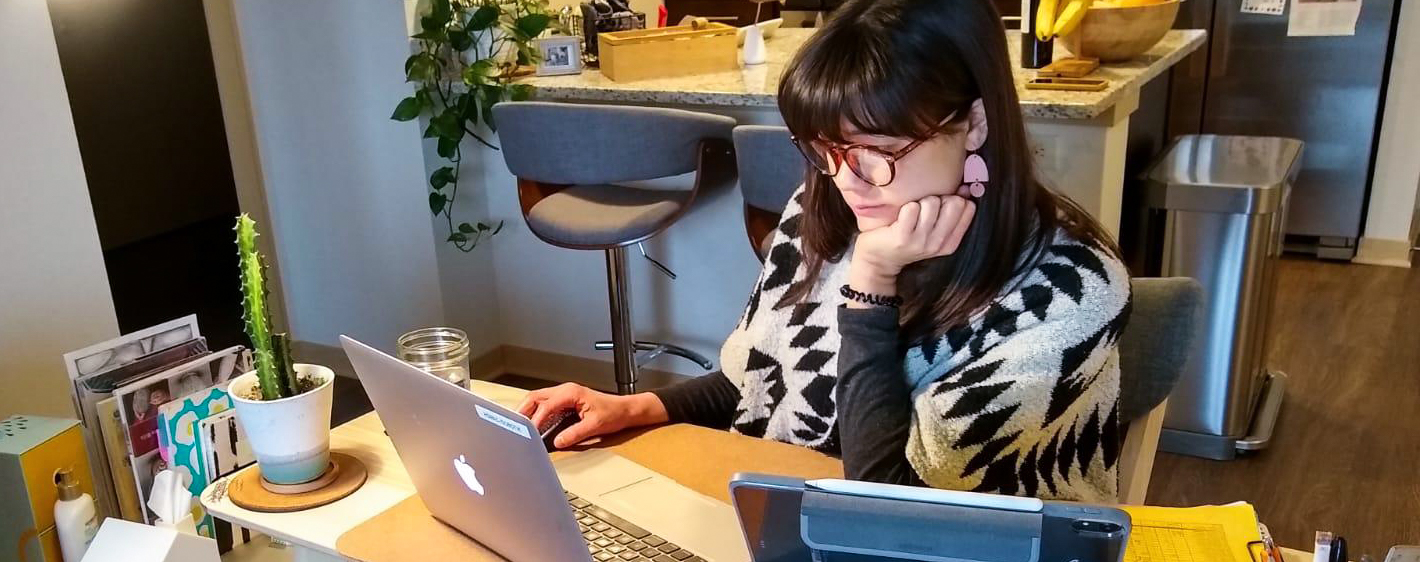
Monona Grove High School art teacher Ida Sobotik working from home
Face Masks
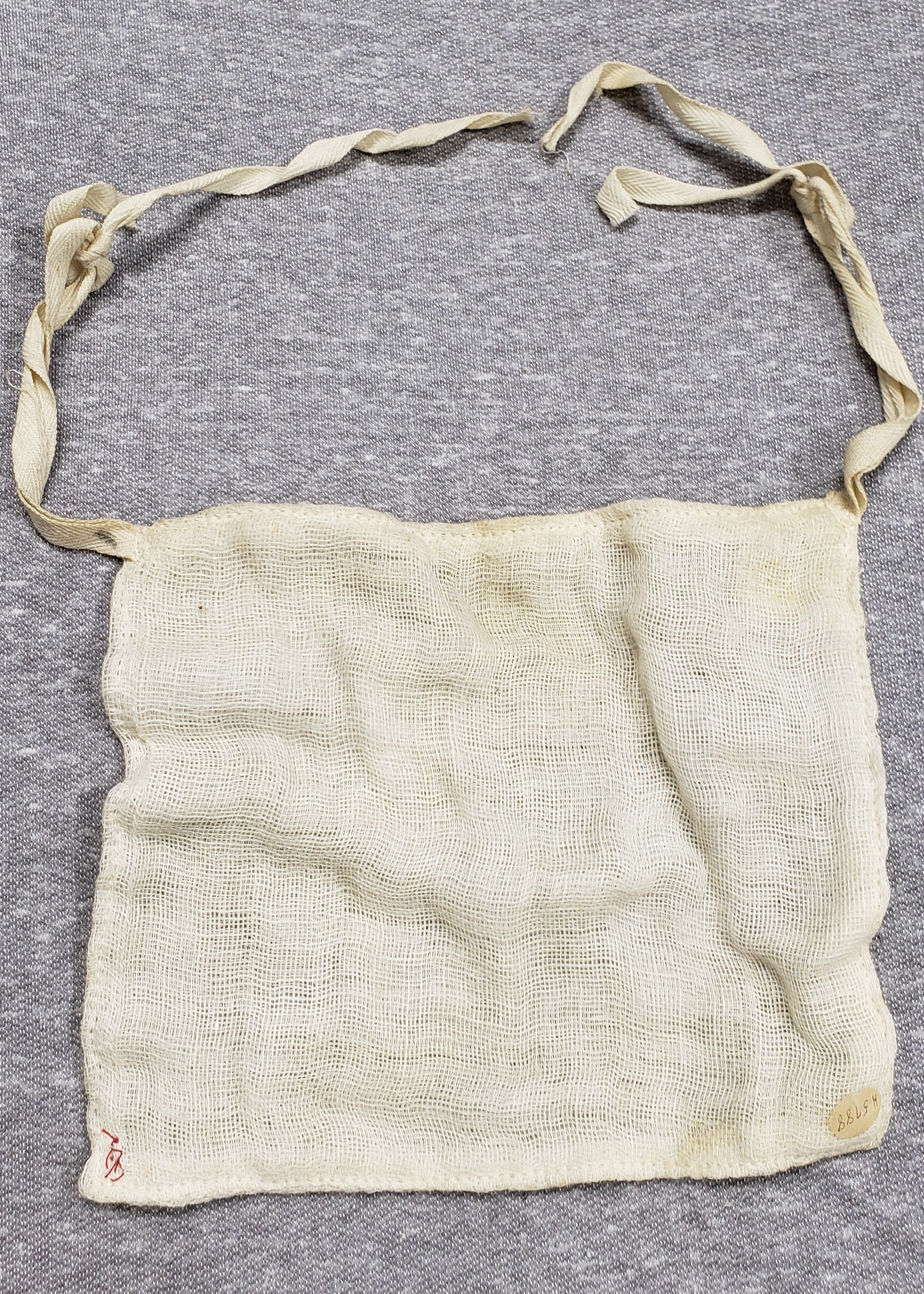
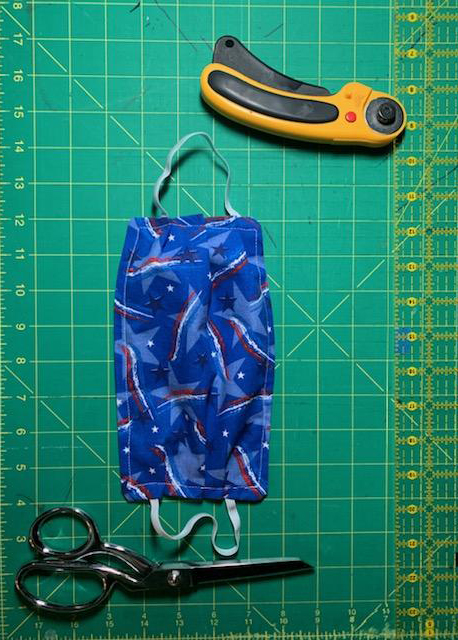
Face Masks
The COVID-19 pandemic of 2020 has forced us to take extreme precautions to avoid contracting and spreading the novel coronavirus. In addition to the closing of schools and businesses, and a heavy emphasis on social distancing, it has been recommended that we wear face masks when out in public. These masks have quickly become the visual icon of the COVID-19 outbreak, much like they were during the last worldwide pandemic of comparable magnitude: the “Spanish flu” of 1918.
In both instances, the sudden and urgent need for protective face coverings has sparked an outpouring of ingenuity by everyday citizens, who have valiantly risen to the occasion in the spirit of public service. Then and now, countless Americans answered the call by fashioning masks out of a myriad of materials, many utilizing their sewing skills to make and donate them to members of their communities.
The image above shows a simple gauze “flu mask,” worn by people in Spokane, Washington, during the 1918 pandemic. It was donated to the Wisconsin Historical Society by 18-year-old Francis S. Lamb of Madison, who was part of the Student Army Training Corp at the time. Lamb (1900-1975) went on to become a lawyer who was elected to the state Assembly in 1933 and later served as general counsel for Wisconsin Gov. Walter Goodland, who served from 1943-47. In 1918, though, the young Lamb understood the historical importance of the moment and sent the mask to Wisconsin Historical Society Museum Director Charles E. Brown (1872-1946). In his accompanying letter, Lamb observed that “by taking preventative measures early,” far West cities such as Spokane “felt the effects of the influenza epidemic much less” than cities in the East. He noted that Spokane officials “required everyone in a public place to wear a ‘flu mask,’” like the one he included, which he wrote were on sale for 10 cents apiece.
Resources
If history tells us anything, it’s that we will respond to and overcome these hardships, together. Here are a few more historical articles and resources related to face masks and the “Spanish flu” pandemic of 1918.
Wisconsin Magazine of History Article 1918 Pandemic Flu Quarantine Sign Cordelia Harvey You Can Help PosterSew a Mask
You can help your local essential workers by sewing a mask and donating it. From healthcare workers to grocery clerks, truck drivers and postal workers there are many essential jobs that require people to still go to work. Help them out by sewing and donating a mask. Before donating any masks check in with the organization to see if there are any specific requirements.
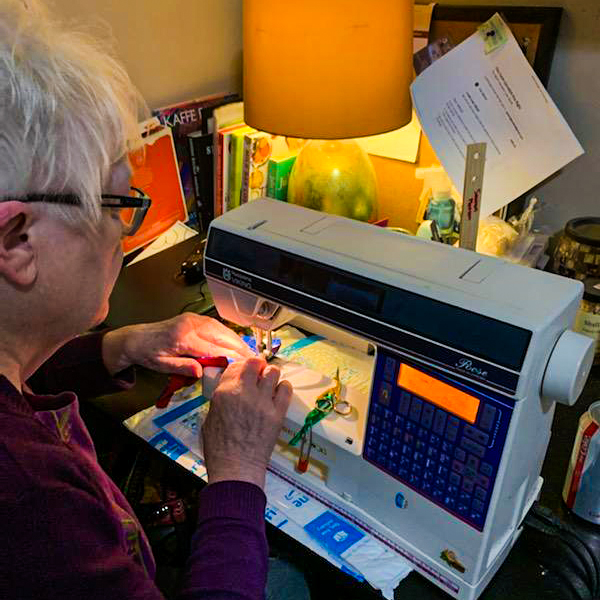
Wisconsin woman, Jeanne Gosselin, sewing masks at home
Pets That Comfort

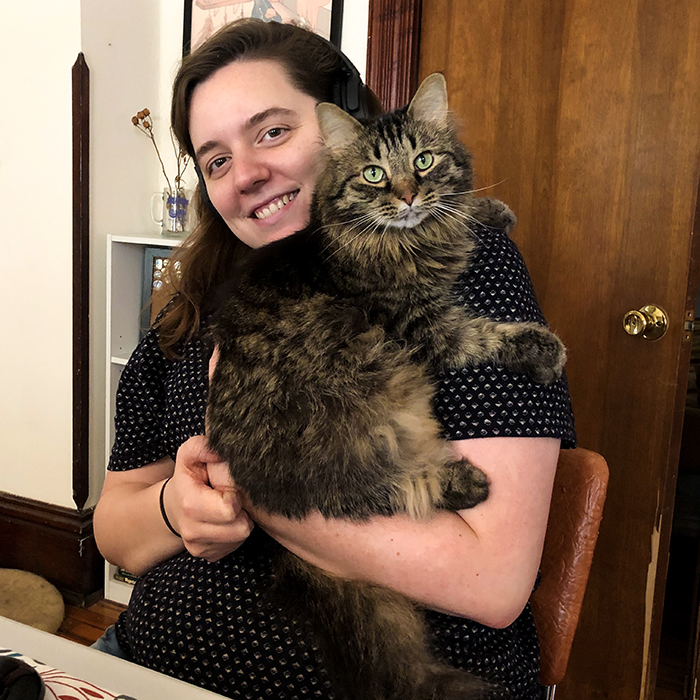
Pets That Comfort
Pets bring us joy, they bring comfort to us in good times and especially in times of discomfort or crisis. With the COVID-19 pandemic around us today, the relationship between humans and their pets has become closer than ever.
They appear in our social media photos, make cameos in our videoconference work meetings and, desperate to beat cabin fever, we’re taking our dogs for more walks than ever before (much to their delight). Meanwhile, shelter and rescue organizations nationwide are reporting unprecedented interest in fostering and adopting pets during the coronavirus outbreak emptying many shelters. The photo above on the right shows Hannah Hankins and her beloved cat, Ferdinand aka Ferd who was adopted from the Dane County Humane Society.
This is not a new phenomenon, however. Then, as now, history is full of examples where people sought distraction and comfort in the companionship of pets when their lives were disrupted, whether by war, economic depression, natural disaster or other difficult circumstances.
During WWI and WWII many animals, especially dogs and cats, provided comfort and companionship to soldiers. Sometimes they also became mascots for an entire squad which was thought to bring the squad good luck. In the above photo on the left from our collection, Lt. Paul Seramur of Milwaukee spends free time with his pup, Cobber, at an air base in New Guinea (present day Papua New Guinea) during a break between bombing missions in the Pacific. It was taken on Nov. 13, 1943 by Robert Doyle of the Milwaukee Journal.
Pets also brought comfort to people living on the home front during the war.
As we continue to shelter in place, pets are keeping us distracted and offering love when needed. So, whether you have a dog, cat, rabbit, lizard or snake, show them how much you care with a little extra affection today!
Resources
Historic Images of Dogs Historic Images of Cats Sport: Ship Dog of the Great Lakes Racine County Humane Society Records, 1935-1968 International Sled Dog Racing Association Records, 1961-1983Adopt or Foster a Pet
Consider adopting or rescuing a pet if you are able to care for one; if you already have a pet, spend a little extra time with it and reflect on the comfort and joy that they bring. Shelters are also looking for supplies or volunteers during this time. Contact your local pet shelter to see how you can help!

The Sandine family with 4-month-old recently rescued pup, Rosie and siblings (from left) James, Derek, Linnea and the family’s 5-year-old dog, Roxy. Both dogs were adopted.
Social Distancing

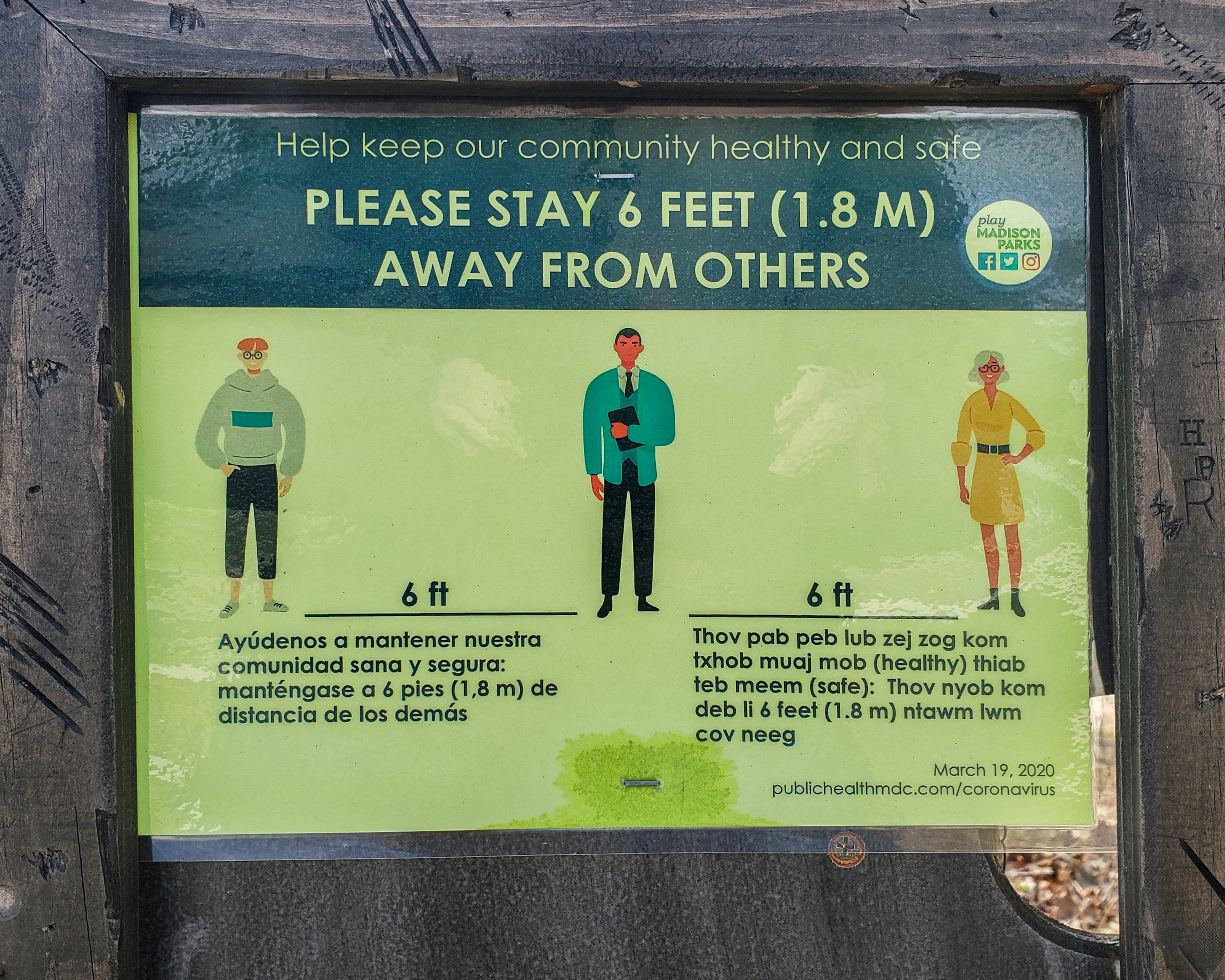
Social Distancing
During national crises, people look to the lessons of history for guidance, comfort, and perspective. As a result, we know that while the concept of social distancing may be new to those of us facing the COVID-19 pandemic in 2020, it is not new. In fact, history shows us that it is a proven method for reducing community spread of infectious diseases.
In the 1910s and ’20s, Wisconsin public health officials posted cardboard signs like the one pictured above on buildings occupied by quarantined victims of influenza, whooping cough, measles and other ailments for which vaccines did not yet exist.
Sadly, more than 8,000 state residents died during the “Spanish Flu” pandemic in 1918. But despite that grim statistic, Wisconsin was quite successful compared to other states because of its robust public health measures — including social distancing — and a high rate of compliance by the public.
The time-tested practice of social distancing combined with quarantining goods, animals, or people believed to be carrying contagious diseases was then, and remains now, the most effective public health measure for fighting a pandemic in lieu of a vaccine. It is why, just like during those early 20th-century outbreaks, we once again see public health advisory signs like the one pictured above on the right, which was posted at a Madison park.
So, as we protect ourselves and our fellow citizens from COVID-19 by staying at home whenever possible, wearing masks and practicing social distancing by remaining at least 6 feet apart when in public, and quarantining ourselves when infected, we do so with the confidence of the lessons learned from history.
Resources
1918 INFLUENZA: WISCONSIN MAGAZINE OF HISTORY ARTICLE INFLUENZA QUARANTINE PLACARD, c. 1910-24 ESSAY: DISEASES AND EPIDEMICS IN WISCONSINBe Kind
During quarantine restrictions, take care of one another. Think of ways you can put a smile on someone’s face. Draw a nice message with chalk on the sidewalk or cut out hearts and place them in your windows. Do what you can to show support for your loved ones and those you don’t know!

Window seat with hearts across the window panes in a beautiful rainbow. Photo by Paige Knipfer
Writing Letters & Staying in Touch
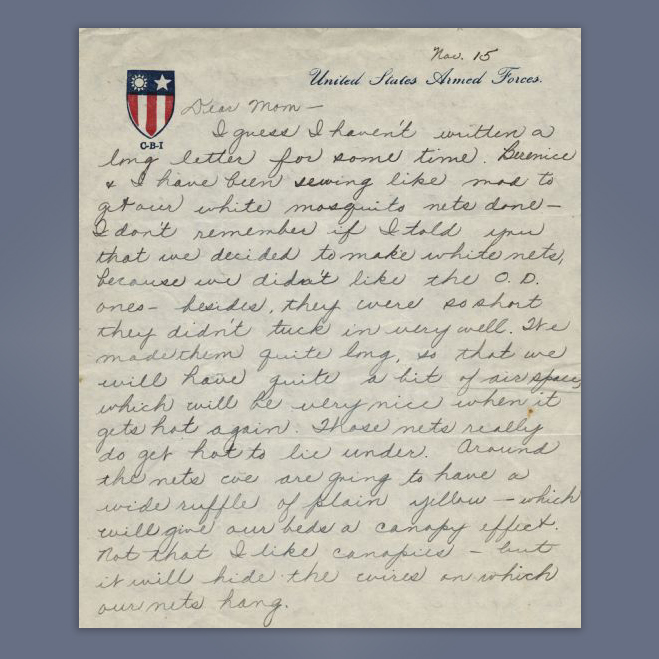

Writting Letters & Staying in Touch
As most of us have discovered during the COVID-19 pandemic, adhering to public health guidelines aimed at reducing the spread of the novel coronavirus — including social distancing and staying at home — can be a lonely proposition. The lack of daily, face-to-face human interactions has forced us to seek other methods to beat the isolation blues and stay in touch with family, friends, co-workers, and others.
For some, it has led to a crash course in 21st-century technology. Videoconferencing platforms such as Zoom, Skype, Google Hangouts, and Face Time have allowed people to gather virtually for family chats, birthday parties, book club sessions or even happy hour toasts. For others, communicating via social media, text messages or email has helped fill the void.
Of course, there is also the time-tested method that has bound our ancestors for centuries and, as a result, informed many a historian’s subsequent research: the hand-written letter, composed slowly and thoughtfully, and sent in a stamped envelope via the United States Postal Service (USPS).
The USPS began in 1775, when, during the Second Continental Congress, Benjamin Franklin was appointed the first postmaster general. It was formally created in 1792 with the passage of the Postal Service Act. The first post office in Wisconsin was established Oct. 6, 1821, in Green Bay, with the second following three years later in Prairie du Chien.
As those who love history know well, letters that people leave behind are invaluable evidence of how life was once lived. We know what our ancestors ate, how they dressed, what they dreamed about, what they thought about warfare, and how they reacted to illness — all from their letters.
While hand-written letters are no longer the number one way to communicate in our modern world, it just might be an effort worth considering during this historic time of COVID-19. Sitting down to write a letter provides time for reflection and engagement without a screen. The recipient, especially those (like our elders) who haven’t been able to leave their homes, surely would enjoy the surprise in the mail and the thoughtfulness of the personalized extra effort. And future generations (not to mention historians) would consider it a rare gift from our high-tech era and cherish the document as an opportunity to learn from the lessons of our once-in-a-century experience.
Regardless of the method of communication, though, we know from history that it is important to keep in touch with loved ones and others during difficult times because we all handle crises differently. Maintaining contact keeps us tethered to each other, allows us to make sure others are OK, and benefits our mental health. It also reminds us that we’re all in this together, and that we will emerge from this shared experience together, too.
Resources
Explore Letters in Our Collection First Practical Typwriter Computer Image 1981Write a Letter!
Reach out and check in with loved ones and others in whatever form works best for you. Consider composing a hand-written letter, note, or card and sending it in the mail. The thought of you taking the time to add that personal touch in reaching out may be just what is needed to brighten someone’s day. Plus, it will probably make you feel better, too.
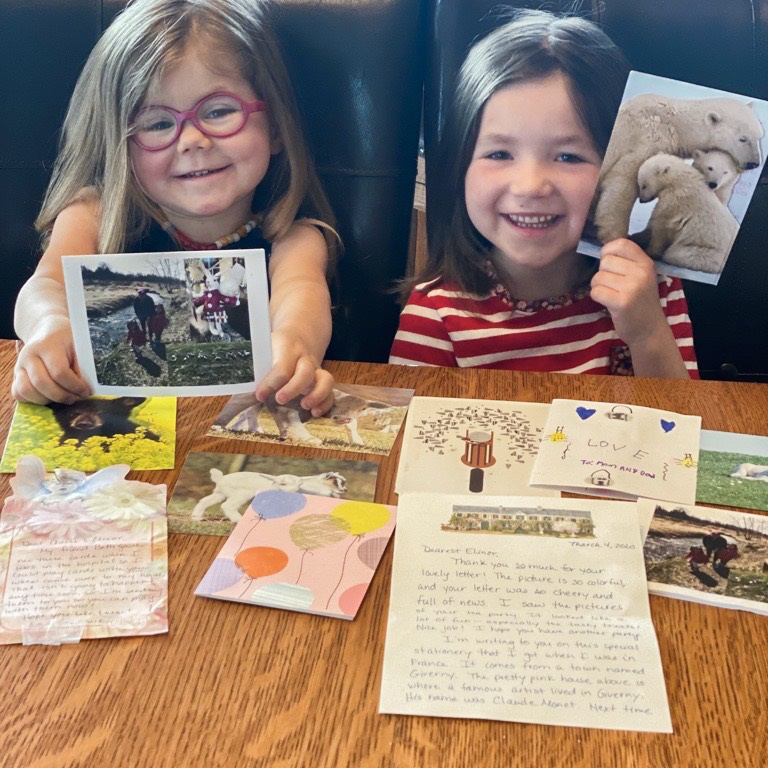
Two adorable girls reading letters from those they care about
Home Delivery
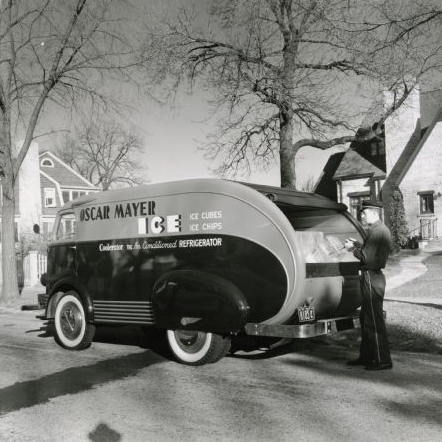
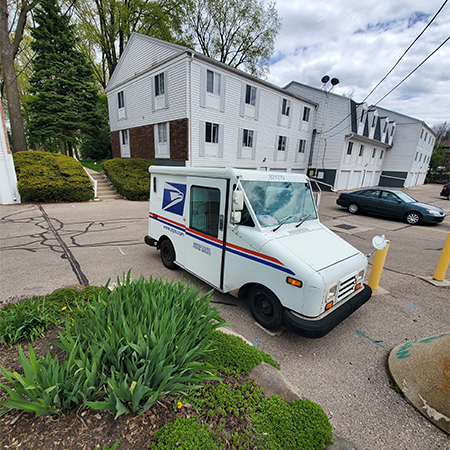
Home Delivery
As we shelter in place to protect ourselves and others during the COVID-19 pandemic, many of us are relying more than ever before — and some for the first time — on home delivery for basic necessities. With the rise of Amazon and countless other online vendors, having products shipped directly to our doorstep has become commonplace in modern society. The outbreak of the novel coronavirus, however, has led to an unprecedented surge in this method of commerce.
In addition to making online purchases from retailers whose physical locations are temporarily closed, more people are trying out services like EatStreet, Grubhub, DoorDash, Uber Eats, and others to have meals from their favorite restaurants brought to their homes. Grocery stores, meanwhile, have seen an overwhelming demand in online ordering and home delivery.
While this delivery surge may seem unique to us in 2020, history informs us that Americans have been ordering goods and services from home since long before the arrival of the internet and modern technology like smart phones.
Mail order catalogs, made famous by retailers like Sears and Roebuck, came into their own in the late 19th century. The Homestead Act of 1862 spurred westward expansion, including the rapid extension of railroad networks. The U.S. Postal Service made it economical to send catalogs by charging only 1 cent per pound to ship them. In 1896, Rural Free Delivery made the distribution of catalogs even more cost effective.
Meanwhile, as many of us may recall from stories passed down through generations, home delivery of ice, coal, and milk was once common. Horse-drawn wagons, and then trucks made daily rounds through residential neighborhoods, delivering coal for home heating in the winter, blocks of ice for refrigeration in the summer, and bottles of milk year-round. Before electric refrigeration was widely available, ice was harvested from frozen lakes and rivers in the winter, then stored and delivered during the rest of the year.
Workers driving insulated wagons or trucks would haul ice to residential houses. In the photo above from the Wisconsin Historical Society’s archives, an Oscar Mayer employee uses tongs to remove a block of ice from the back of his truck as he makes a delivery to a residence in the Madison suburb of Maple Bluff in 1940. Residents would usually have a card or sign in their window that indicated how much ice they needed. The “ice man” would use tongs to carry a block of ice into the house and place it in an ice box, which would eventually be replaced by electric refrigerators. The ice industry was already well established when Wisconsin became a state in 1848. With its cold winters and abundant waterways, and demand from breweries and meat packers, Wisconsin developed a very active ice harvesting industry through the early 20th century.
So as those packages, meals, groceries and other items arrive at your doorstep during these unusual times of the COVID-19 pandemic, take solace in knowing that you’re part of another chapter in Wisconsin’s long and celebrated history.
Resources
Ice Wagon Cartoon Oscar Mayer Ice Delivery Truck Conklin Ice House on Lake Mendota Harvesting Ice on the Milwaukee River Man delivering milk in a Milwaukee Rural Free Delivery 1915 Sears catalog Magazine of History article about the ice industry Ice Industry images McCormick-International Harvester Delivery Trucks Collection Miller-Rasmussen Ice Company of Green Bay George Buckner, African-American Ice DelivererThank a delivery person!
Express your thanks to those who continue to work in warehouses, load trucks, transport packages and deliver them to your door. Write a message in chalk on your front step, leave bottles of water or snacks in a basket , leave a tip or just wave through your window as a way of saying thanks to those who continue to bring necessities straight to our front doors!

Davis Campbell, Decatur Cartage Company's safe driver, in an International truck.
Board Games & Cards
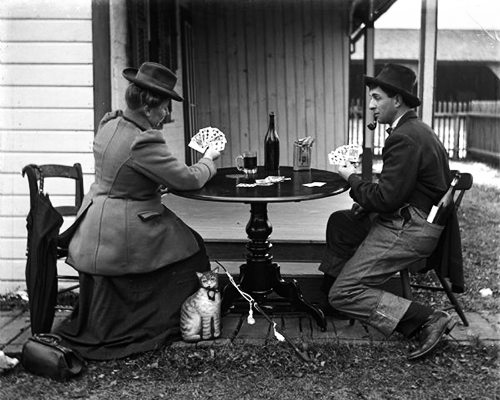
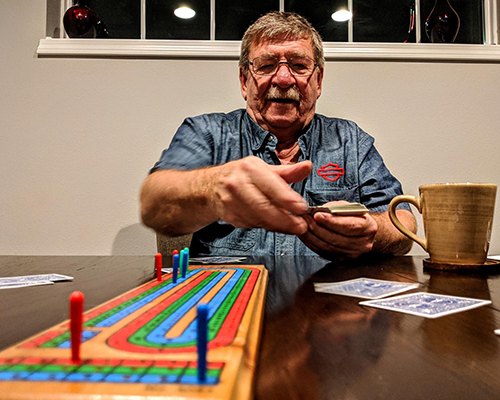
Board & Card Games
As we follow public health guidelines during the COVID-19 pandemic by staying at home as much as possible to avoid contracting or spreading the coronavirus, more families are realizing that there’s only so much Netflix, Hulu, and other streaming video services that they can binge. As a result, many are turning to a form of entertainment that has delighted people for centuries: Board games and card games.
Anecdotes abound of adults turning back the clock to their past by playing — and teaching children — classic board games such as Clue, Life, Risk, Monopoly or Trivial Pursuit, card games like Cribbage, Euchre, Uno or Rummy, or myriad other options.
In a time of Zoom meetings, virtual learning, online communities, and quarantines, disconnecting and sitting down with family members to play a board or card game is a great way to have fun and spend low-stress time together.
Then
The world’s oldest board game is thought to be Senet, which was played in ancient Egypt more than 5,000 years ago, and dice games date back even earlier.
The earliest settlers in New England thought games were frivolous (or worse), and since our country was largely agrarian in the 17th and 18th centuries, with hard, physical labor the norm for most people, there was little time for playing games.
As the United States shifted to more urban living in the 19th century, games became more popular as they began to be commercially produced. These early games were often designed to teach children literacy or instill them with moral or religious values.
The 1880s to 1920s are considered the height of board game popularity in the U.S., when mass production made them cheaper and more widely available. Leading up to that golden era was the arrival of Life, which was created in 1860 by Milton Bradley as The Checkered Game of Life (later shortened to The Game of Life, then Life). Among the aforementioned games, Monopoly came along in 1935, Clue in 1949, and Risk in 1957. Trivial Pursuit ushered in a more modern revival of board games and popularity for trivia knowledge with its debut in 1979.
Now
We are living in a new golden age of board games, with an estimated $8 billion in global sales expected in 2021. With COVID-19 keeping us inside so much, the idea of losing oneself in another time or place or situation through a board game is proving very appealing to many people.
Resources
Playing Cards (1906) Playing Carrom (ca. 1900-1921) Cribbage Game at Fire StationPlay a Game!
Dust off that old board game in your closet, pull out a deck of cards or learn to play a board game online. There are many ways to interact with friends and family through a fun board or card game. Need some suggestions? Check out the games and puzzles for sale on the Wisconsin Historical Society’s online store.
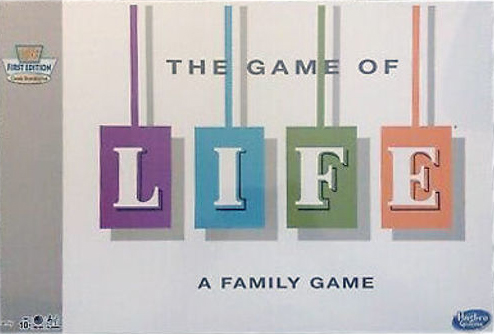 Shop Now
Shop NowSeeds & Home Gardening
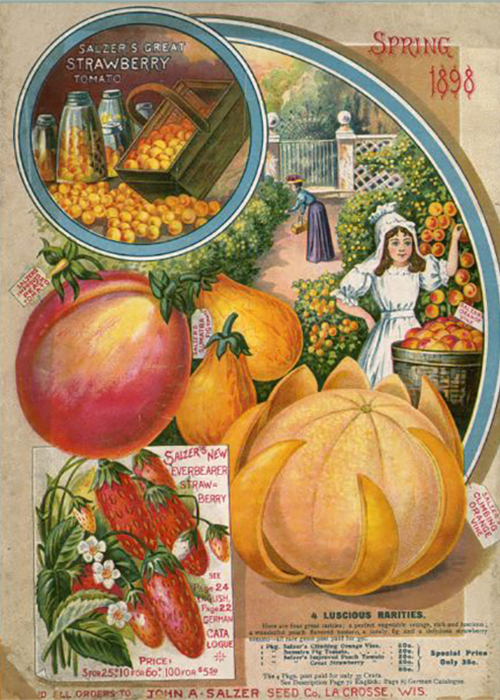
For decades, seed catalogs were the most popular way for home gardeners to order their products. This is the back cover of the John A. Salzer Seed Company catalog from 1898, which is part of the Wisconsin Historical Society collection.
WHI Image 129544
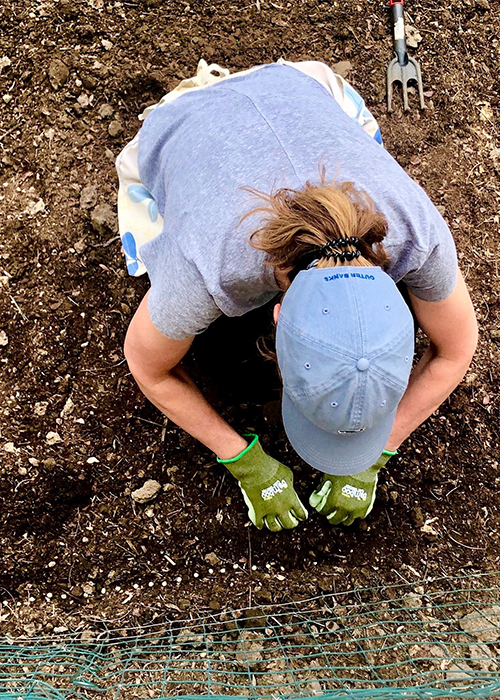
While many may no longer order seeds through catalogs (though they do still exist), today’s home gardeners still plant them just like their parents and grandparents. Here, Nettie Witter of McFarland plants peas in her backyard garden.
Credit: Dean Witter
Seeds & Home Gardening
Wisconsin is nationally known for its proud agricultural history, but the COVID-19 pandemic is sparking a new appreciation for this beloved part of our state’s heritage.
As warmer weather arrived with the calendar turning to the seed-planting month of May, many people staying home are deciding that this is the perfect opportunity to give gardening a try for the first time, or expand on previous harvests.
Some are dipping their green thumbs in with limited container gardening, while others are going all-in by cultivating a patch of their yard. As a result, businesses that sell seeds and plants are reporting record-breaking demand.
It represents the latest chapter in Wisconsin’s history of residents taking advantage of our state’s fertile soil.
Then
Throughout the state’s history Wisconsinites have gardened for subsistence, as landscape ornamentation, and as a pleasurable pastime.
Native Americans have tended the soil for over 2,000 years. The first gardeners domesticated native crops such as squash, sunflowers, and lambsquarters. Between the years 1000 and 1400, corn and beans arrived from the South and were added to the mix. Native peoples carefully managed soil chemistry to enhance fertility and sustainability, crafting distinctive ridged fields that still survive in a few locations.
Settlers from the East and Europe integrated their own gardening traditions. Europeans introduced crops such as melons, potatoes, and millet to Native populations, and in return accepted corn, squash, and beans for their own gardens.
During World Wars I and II, citizens were encouraged to grow their own food to support the war effort. “Victory Gardens” were promoted as a way to direct more of the nation’s food production to the armed forces and refugees overseas. They were part of a wider program of self-sacrifice for the greater good that included the rationing of materials such as rubber, paper, and gasoline; and the purchase of war bonds and stamps, among other supportive actions. A Victory Garden was a way to show your participation in the national effort, but also offered the practical benefit of growing your own food when shortages and rationing were common.
Now
There are countless reasons for the surge in agricultural attraction during the COVID-19 pandemic. For some, it’s a chance to rekindle traditions passed down by ancestors who grew up on family farms. For others, it’s a way to keep busy while at home, or to engage children in a meaningful and long-lasting project. Some see it as a practical source of food and an opportunity to avoid the potential risk of extra trips to the grocery store. At the very least, gardening is an excuse to get outdoors and relax while engaging in a rewarding activity away from the cares of the world.
Media outlets from New York to San Francisco have covered the surge in garden-related sales. A Milwaukee Journal Sentinel story reported on a firm that had to temporarily stop taking new inquiries after orders had doubled from the previous year. “People are looking to get into it whether it’s for growing their own food or having a project to do at home,” Nathan Zondag, vice president of J.W. Jung Seed Co., told the paper. The Journal Sentinel also spoke to others facing similar demand. “We are selling out,” added Zannah Crowe, horticulturist at Johnson’s Gardens in Cedarburg. “It’s a nationwide trend. There is a huge, huge demand for it. … I hope these people have success because then we have a whole new generation of gardeners.”
"We are 500% busier than we normally are this time of year," Mario DiGrande, owner of Oakland's Thornhill Nursery, told the San Francisco Gate. "I've already sold as much soil in six weeks that I do in an entire year. It's just crazy."
Resources
World War I Victory Garden Poster World War II Victory Garden Poster Garden Wisdom: Lessons Learned from 60 Years of Gardening Vintage Wisconsin Gardens: A History of Home Gardening Putting Down Roots: Gardening Insights from Wisconsin’s Early Settlers Garden Business Surge Milwaukee Journal Sentinel Vintage Seed Catalogs International Harvester Victory Gardens Heirloom Garden Month at Old World WisconsinPlant A Garden!
Consider planting and tending a garden this season as a way to relax outdoors, keep busy, and/or provide some fresh alternatives for the table. A bounty of tomatoes like this could be yours!
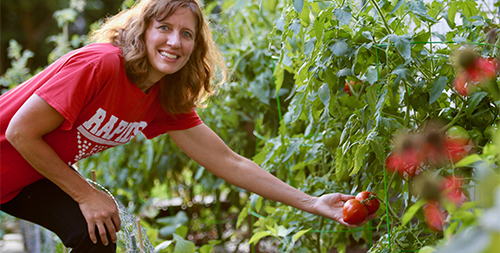
Nettie Witter shows off her tomato crop last year in the backyard of her McFarland home. Credit: Dean Witter
Food Rationing & Preparedness
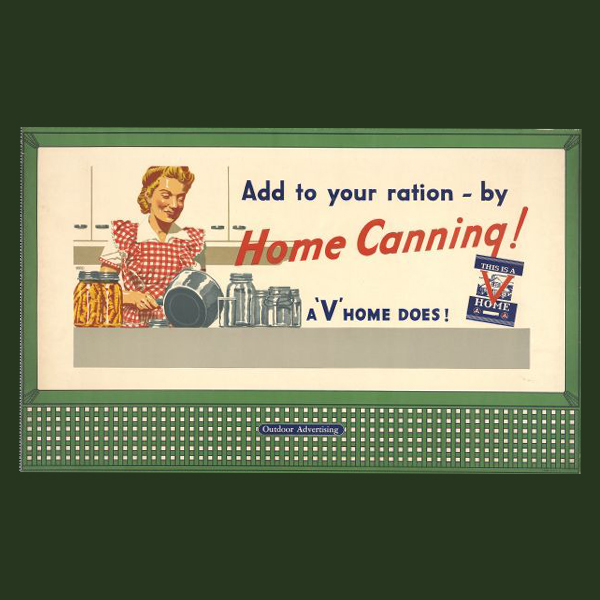
This public information poster, put out in 1943 by the Office of Civilian Defense when rationing was in effect during World War II, encourages residents with “Victory Gardens” to add to their food supply by canning at home.
WHI Image 66866
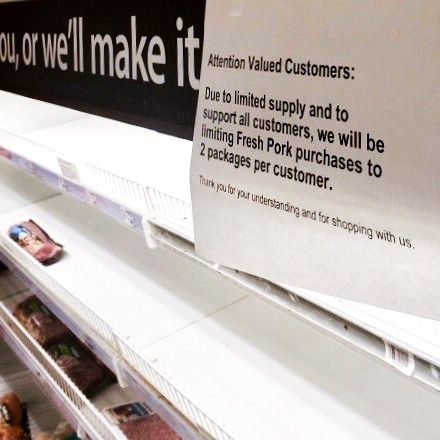
Signs at grocery stores, like this one at a meat department, alerted customers to a purchase limit after a rush early in the COVID-19 pandemic caused supply shortages. Other in-demand items included soup and other canned goods, pasta, and flour.
Credit: Dean Witter
Food Rationing & Preparedness
While it hasn’t risen to the level of extreme rationing and sacrifice required during World War I and II, or the concern for food preparedness during the Cold War, the current COVID-19 pandemic has provided modern Americans a taste of what a disruption of the food supply — even a temporary one — could mean to our daily lives, while also offering a lesson in the value of food preparedness measures such as canning.
Facing potential job losses and the prospect of sheltering in place at home for an undetermined length of time, Americans rushed to grocery stores and other outlets during the first weeks of the current pandemic. This enormous and unexpected surge in demand quickly outpaced supply, forcing store managers to begin limiting purchase quantities of certain products.
This experience has been unlike anything many Americans have ever faced and, as a result, it has given most of us a new appreciation for history and the sacrifices for the greater good made by elders from previous generations.
Then
World War I and II were crises of a global scale that greatly disrupted the food supply chain. Among many other efforts to support and supply the war effort, these events prompted the U.S. government to implement rationing, which was the planned limiting of quantities of crucial foods to ensure equitable distribution to citizens everywhere.
These events, followed in subsequent decades by fears stoked by the Cold War, motivated citizens to grow and store more food at home by canning, the process of preserving fruits and vegetables under pressure in sealed containers utilizing the home stove.
Most of the produce for home canning came from the backyard garden when it was ripe and in abundance. During the two world wars, the federal government promoted the “Victory Garden” program, which encouraged Americans to support the war effort and exemplify national sacrifice by growing their own crops at home.
Now
The current pandemic is also a global crisis that has disrupted the food chain, especially since our supply system has become increasingly globalized. In addition, the close proximity of working conditions inside food processing facilities, especially meatpacking plants, led to breakouts of COVID-19 and resulted in the temporary closure of some of these critical supply locations.
Government authorities have not implemented rationing in response, but as previously mentioned, the initial rush on grocery stores forced most stores to limit quantities of certain foods and goods. For example, meat department shelves rapidly emptied, as did aisles of pasta. Many people prepared for a potentially long period of home quarantine by clearing out shelves of soup and other canned goods, while others sought refuge by binge baking at home, which led to temporary shortages of staples such as eggs and flour.
In addition, there is also a renewed interest in gardening with “Covid Victory Gardens,” as well as in kitchen canning, leading to a significant surge in the sale of seeds and plants. Learn More from the May 26 Then & Now Seeds & Gardening
Resources
LIFE DURING COLD WAR ONLINE EXHIBIT 1960 FALLOUT SHELTER MULTI-PURPOSE FOOD 1943 WOMAN CANNING 1917 CANNING POSTER 1937 GARDEN & CANNING BOOKLET 1918 WAR GARDEN 1917 VICTORY GARDEN STORE WINDOW WWII VICTORY GARDEN POSTER WWI WAR GARDEN POSTER WWI ‘MORE FOOD IS PATRIOTISM’ POSTERDonate Food To A Local Pantry!
With supplies still fluctuating at local grocers and so many people out of work, donating canned goods and other non-perishable food items to your local food pantry can make all the difference for a family in need. For those with gardens, take the time to learn how to can food at home to make your bounty last longer, especially for when produce isn’t as easily available at stores or markets.
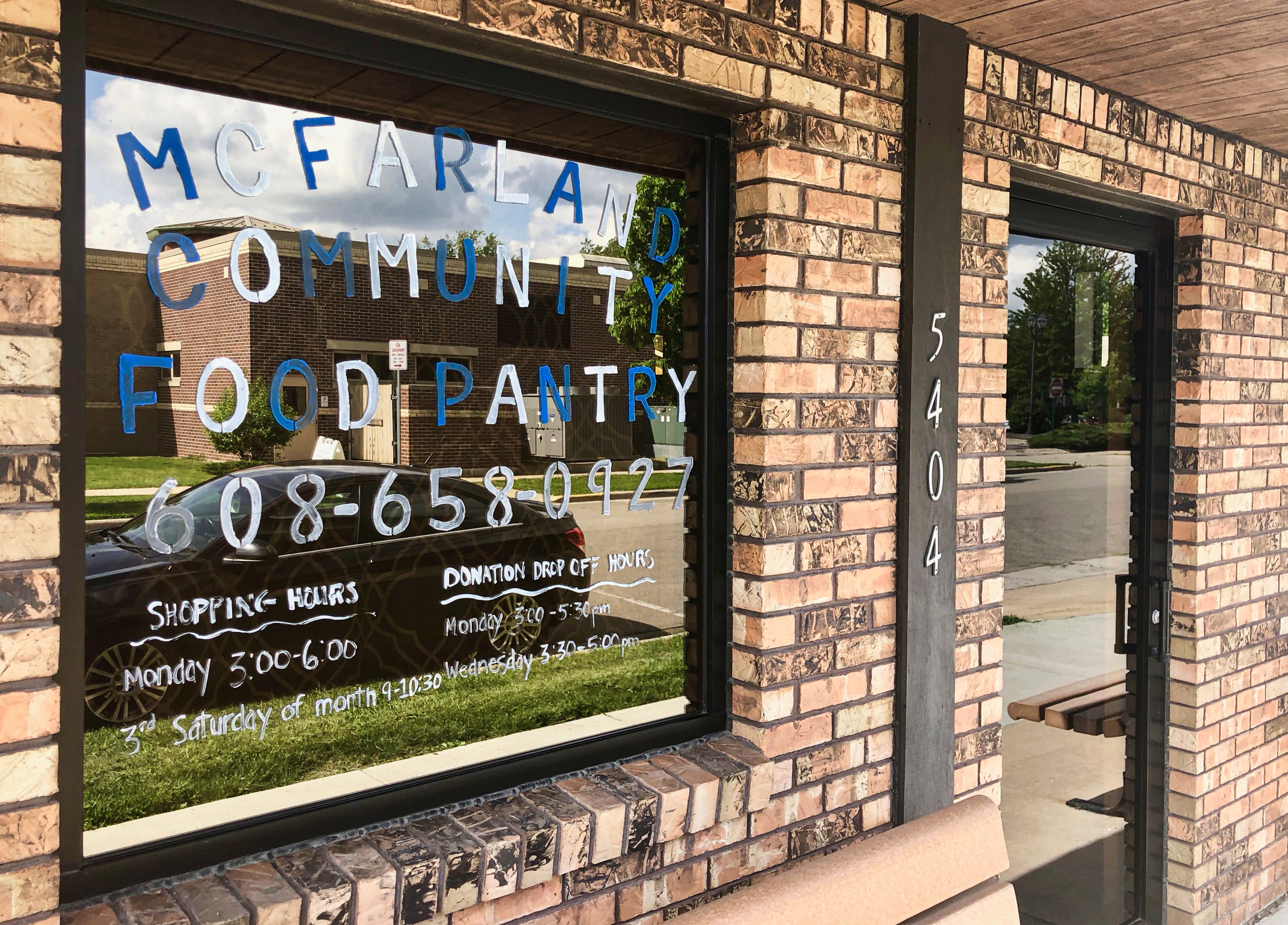
MacFarland's food pantry. Credit Dean Witter
